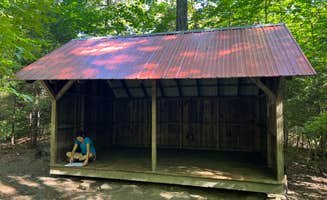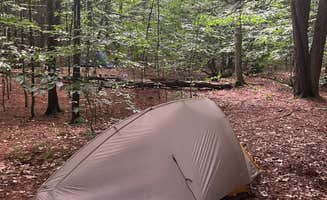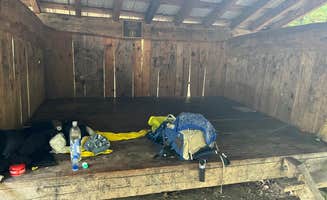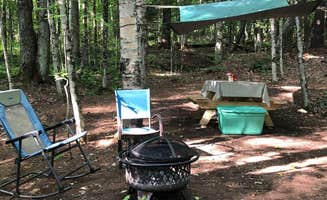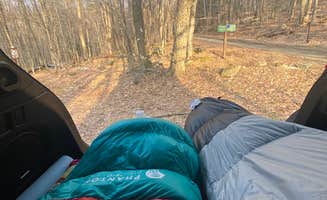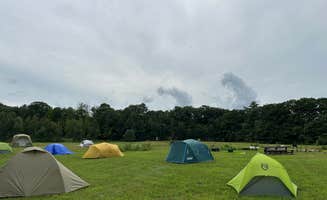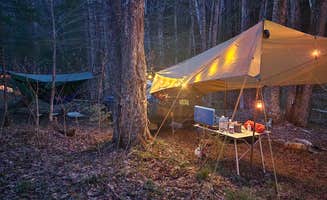Tent camping options in Brownsville, Vermont provide direct access to the Green Mountain National Forest ecosystem at elevations ranging from 700 to 2,500 feet. The area features northern hardwood forests dominated by sugar maple, beech, and yellow birch trees with seasonal water availability highly dependent on recent rainfall patterns. Most primitive camping areas require campers to pack in all supplies and follow Leave No Trace principles.
What to do
Explore swimming holes: Stony Brook near Stony Brook Backcountry Shelter offers cooling options during summer months. "I only explored a bit offtrail down the brook but found a decent swimming hole (could just barely submerge myself) to clean off a bit," notes one camper who stopped while hiking.
Overnight on section hikes: The Appalachian Trail shelters provide strategic stopping points for hikers tackling Vermont segments. "I tented here on a section hike of the AT. The shelter was a fairly basic 8ish person shelter, but this stop stood out because of a brand new privvy, large tenting areas, and a swimming hole," reports a hiker who appreciated the amenities.
Winter exploration: Michigan Brook Road camping areas remain accessible during winter with proper equipment. "If you would like to continue down the service road during winter months I would highly recommend snowshoes or a snowmobile. I attempted to bring my car and was stuck overnight but was able to dig myself out the next morning," cautions a winter visitor to Michigan Brook Road Camping.
What campers like
Multi-level shelters: Some AT shelters offer unique sleeping arrangements. At Happy Hill Backcountry Shelter, "The shelter had a ground floor and a loft but each floor could maybe fit 4-5 people comfortably. The loft was nice since folks could decide to sleep up there while others were down below, either cooking, arriving, or departing."
Level tent platforms: Campers frequently mention terrain quality for tent placement. "There were a bunch of level tent camp sites around the shelter," notes a visitor at Happy Hill, which matters significantly for comfort during overnight stays.
New facilities: Recent shelter improvements receive positive mentions. "The privvy looked brand new and was more spacious than most on the trail," reports a camper at Stony Brook, while another notes that Moose Mountain has a privvy that was "new and very spacious."
What you should know
Limited connectivity: Cell service is nonexistent at most backcountry sites. At Michigan Brook Road camping, a camper warns: "THIS LOCATION DOES NOT PROVIDE CELL PHONE SERVICE OR WIFI CONNECTION. However, if you walk to the end of upper Michigan Brook road you will have cell phone service and a gas station along with a United States Post Office."
Seasonal water availability: Water sources are unreliable, especially during dry periods. At Moose Mountain Backcountry Shelter, visitors note "There can be seasonal water sources but water is not guaranteed."
Road conditions: Access roads to drive-in dispersed camping can be challenging. "Beware that in Spring the road gets muddy and quite rutted, I would not recommend driving down there with a car that is low to the ground," advises a camper at Michigan Brook.
Tips for camping with families
Destination selection: For families seeking dedicated facilities, Little Rock Pond Group Camp offers more amenities than standard AT shelters. "There's a big 3-wall cabin with room for at least 12, several tent platforms, and there's even a composting privy (#2 only)!"
Swimming options: Kids enjoy natural water features during summer visits. At Little Rock Pond, "The pond is surprisingly warm for its altitude and it's home to two Common Loons. There's a huge jumping rock on the far side of the pond."
Space requirements: Look for sites with ample flat terrain. At Winturri Backcountry Shelter, a camper noted, "There were lots of tent camping spots as you worked up the hill perpendicular to the shelter," which provides options for family-sized tents.
Tips from RVers
Vehicle clearance: RV access to dispersed camping requires careful vehicle selection. At Michigan Brook, campers advise: "Drive in about a mile after the parking lot!! Can use car to get in! There's 3 camping spots. 1 before the bridge and 2 after the bridge!"
Access limitations: Some roads initially appearing suitable for RVs may become impassable. "Road goes in pretty far. Some parts are muddy and very rough. Higher clearance would be advised!!!" warns a Michigan Brook Road visitor.
Setup locations: Identify specific spots suitable for larger vehicles. "The area is big enough to bring an RV if you can get it down the dirt road," notes a camper who visited Michigan Brook, though they caution about the condition of access routes.


